The Best Potted Palm Trees For Outdoors (With Pictures) – Identification Guide

Growing a potted palm tree can add a tropical touch to your garden landscape. Many small, dwarf, and miniature palm trees are suitable for growing in containers. Living in tropical or semi-tropical climates allows you to grow potted palms outdoors throughout the year. In temperate climates, you can take the palm tree pot outdoors during the summer season and overwinter it indoors.
Growing tropical palm trees in pots is relatively straightforward. The best palm trees for a container garden, patio, or entranceway should be drought-tolerant, low maintenance, and have relatively slow growth. All you need for the palm tree to grow well is a large pot and a well-drained, loamy potting mix.
This article is a guide to growing a potted palm tree outdoors. You will find helpful tips on how to grow a palm tree in a pot. Additionally, descriptions and pictures of small palm trees in pots will help you choose the best variety for your front or backyard.
The Best Palm Trees to Grow in Pots
Choosing a suitable palm to grow in a planter is crucial. Not all palm trees flourish when they are planted in pots. Some palms are fast-growing and will quickly outgrow the container. Other tall varieties of palm trees can become unstable in storms and windy conditions
Some of the best palms for growing outdoors in pots include the areca palm, European fan palm, pygmy date palm, and the lady palm. These palms grow just as well in pots as they do in the ground. As a result, you will often see these palms gracing Florida landscapes, where they thrive year-round outdoors.
Outdoor Potted Palms in the Garden Landscape
Palm trees growing in containers outdoors have many uses in a front or backyard.
Some medium-growing, potted bushy palm trees are ideal for privacy. Palms with arching, feathery fronds look stunning in terracotta pots on a patio, beside an entranceway, beside a pool, or in a landscaped garden. You can also grow tall potted palms for shade on a deck area.
Bushy palm trees like the areca palm can be planted to create an evergreen privacy screen.
Potted Palm Trees For Outdoors (With Pictures) – Identification
The following guide helps to identify potted palm trees for your garden. You will find out the best varieties of palms for container gardening and where to grow them. Additional information about dwarf, miniature, and baby palms will help you choose the best type to complement your landscape.
Areca Palm (Dypsis lutescens)
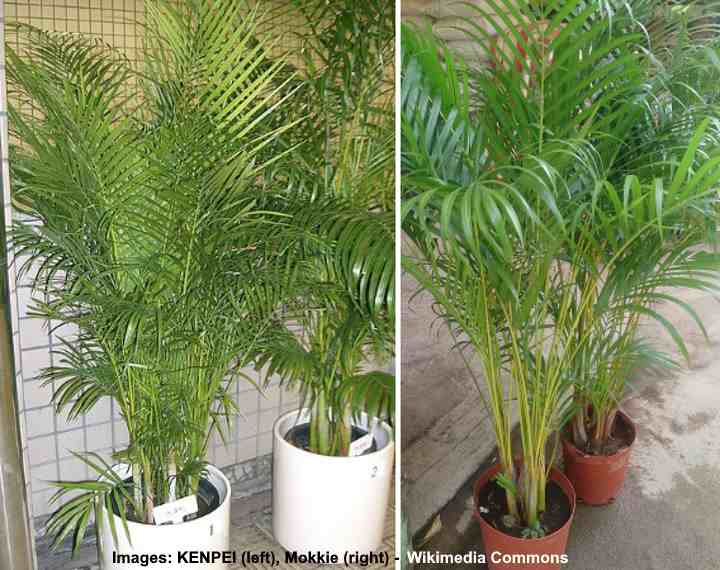
Potted areca palm gives a tropical look to any outdoor space
The areca palm tree is identified by its arching green fronds and smooth green stems. The areca palm plant is a clumping palm that grows well outdoors in clay pots surrounded by summer flowers. In a pot, areca palm trees grow up to 21 ft. (6.5 m) tall; however, the pot size will limit the palm’s height.
The areca palm is also called the butterfly palm, golden cane palm, and yellow palm. With its shrub-like habit, the bushy palm tree is suitable as a shade tree, privacy palm tree, or privacy screen. Grow in full sun to partial shade for best results, and give it plenty of water.
Potted areca palm trees are suitable for growing outdoors in USDA zones 10 – 11.
Chinese Fan Palm (Livistona chinensis)
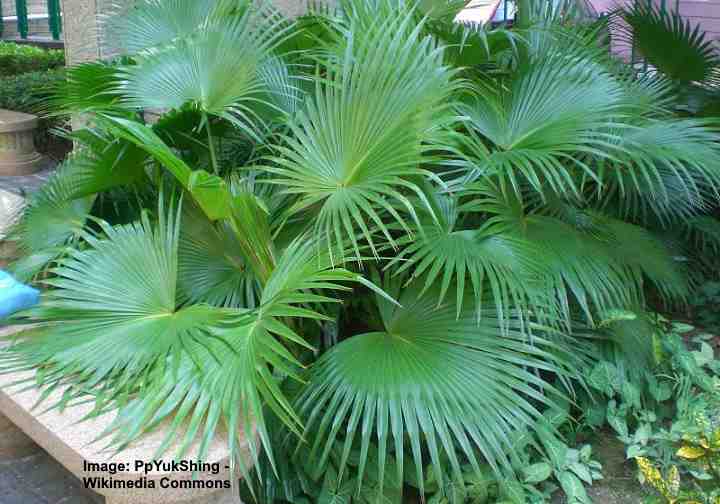
A potted Chinese fan palm can take a lot of space outdoors
The Chinese fan palm has characteristic palm fronds in the shape of a spread-out fan. The star-shaped palmate leaves are dark green and measure 3 to 6 ft. (1 – 1.8 m) across. The slow-growing Chinese palm plant grows around 10 ft. (3 m) tall in a container and enjoys full sun to partial sun.
The Chinese fan palm is identified by its spectacular canopy with a fountain-like look with slightly drooping leaves. The multi-stemmed palm tree is well suited to container growing. It makes a beautiful specimen plant in a patio or decking area. As a cold-hardy, drought-tolerant palm, it is a versatile tree for most gardens.
Suitable for USDA zones 9 – 11. The Chinese fan palm is also on the list of excellent palms for growing indoors.
Cat Palm (Dypsis lutescens)
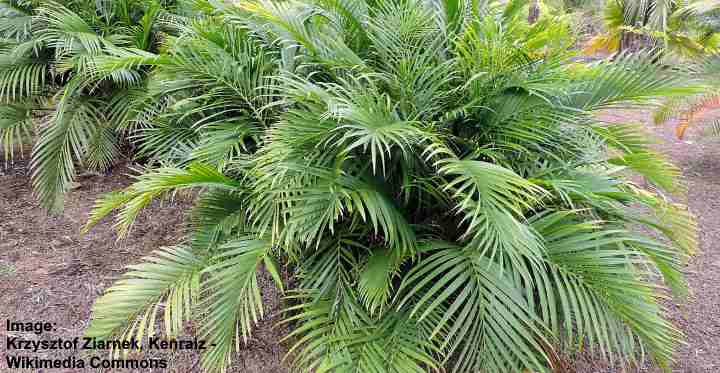
The multi-stemmed potted cat palm is a great choice for landscaping your garden
The cat palm is a small clumping palm tree, identified by its cascading dark green feathery fronds and growing up to 3 ft. (1 m) from the ground. Cat palms are trunkless palm bushes that form a clump of dense foliage. A cat palm will grow around 6.5 ft. (2 m) in a container outdoors.
The best place to put a potted cat palm tree is in dappled shade, ensuring the potting mix is kept moist. The cat palm requires frequent watering in full sun to keep its pinnate fronds of long leaflets dark green and healthy.
Suitable for USDA zones 9 – 11.
Related reading: How to grow the cat palm indoors.
Ponytail Palm (Beaucarnea recurvata)
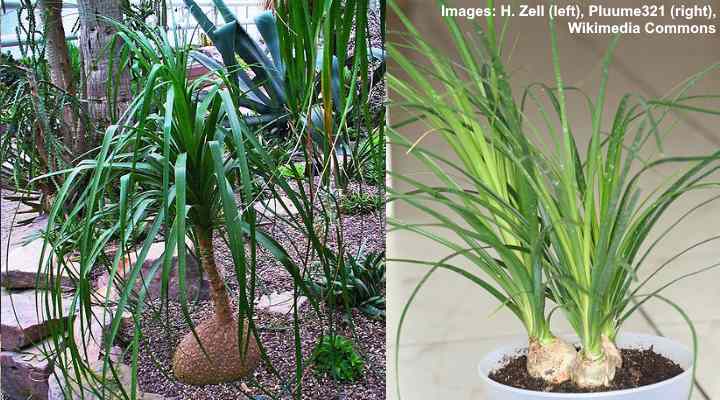
The unique look of the ponytail palm makes it an attractive potted palm tree to grow outdoors
The ponytail palm is a spectacular evergreen palm tree to grow outdoors in containers because of its easily identifiable bulbous trunk and bright green curling grassy leaves. In some cases, several thick stems grow from the swollen base, giving the palm tree a distinctive appearance.
Ponytail palm trees grow up to 6 ft. (1.8 m) tall in containers and require full sun to thrive in USDA growing zones 8 to 12.
The ponytail palm is also called the bottle palm or elephant’s foot palm. This refers to the swollen part of the trunk at ground level. This part of the tree stores moisture, making the ponytail palm exceptionally resistant to drought. Grow this potted palm to create a dramatic focal point in a semi-tropical garden.
Silver Saw Palmetto (Serenoa repens)

Saw palmetto is a small palm tree that can be grown outside in a container
Silver saw palmetto is a spreading, low-growing palm tree with stiff, pointed leaflets growing in a fan shape. The clustering stems of the leaves have sharp spiny teeth, which is why it’s called the saw palmetto palm. The spiky palm leaves grow 3 to 6 ft. (1 – 2 m) long.
Silver saw palmetto palm is a suitable container plant for Florida landscapes. In coastal areas, the green leaves take on a silvery appearance. In addition, the palm tree’s tolerance to sun, humidity, and salty air makes it suitable for growing along the coast.
Suitable for USDA zones 8 to 11.
Parlor Palm (Chamaedorea elegans)
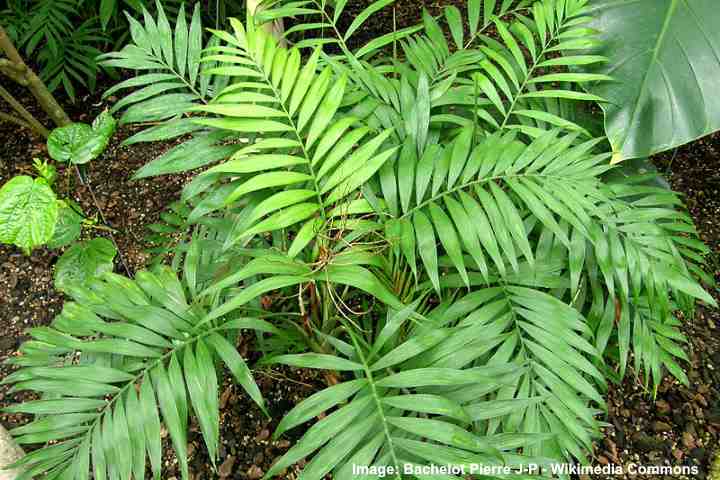
The parlor palm is one of the most popular palm plants to grow in a pot outdoors in warmer climates
The parlor palm is a small, slow-growing palm tree with multiple slender green trunks, pinnate green leaves, and small yellow or orange-red flowers. Growing in pots outdoors, a parlor palm plant can reach 6.5 ft. (2 m) tall. The palm’s arching fronds measure up to 8” (24 cm) long, growing on stems 5 ft. (1.5 m) tall.
Parlor palms are suitable for growing in USDA zones 10 to 12. The attractive container plants are useful for providing shade on patios, decking areas, or around outdoor pools. Put the potted palm tree in dappled sunlight or deep shade for best results.
Majestic Palm (Ravenea rivularis)
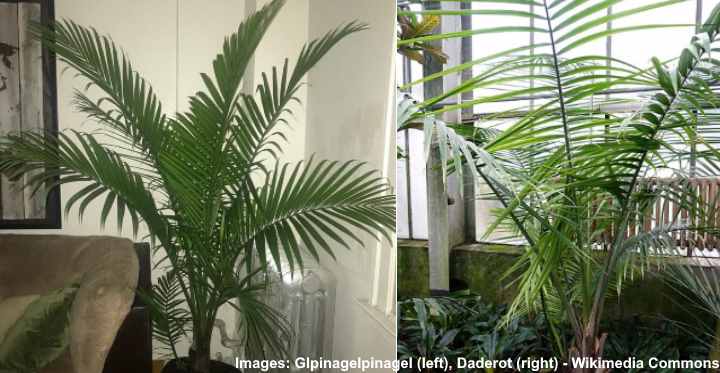
The majestic palm is a slow growing palm plant that requires humidity to grow well
The majestic palm is a tall outdoor potted plant for privacy in a tropical or semi-tropical landscape. Also called majesty palm, the tree’s stately appearance enhances the aesthetics of a landscape. Growing in containers, the long, arching fronds can grow 6 to 8 ft. (1.8 – 2.4 m) long.
Majestic palm trees are relatively easy to grow and are tolerant of damp, moist conditions. Because of the potted palm’s widespread, it’s best used as a specimen plant in warm, humid landscapes in USDA zones 9 to 12. However, it’s good to note that it’s not suitable for planting in coastal regions.
Bamboo Palm (Chamaedorea seifrizii)

Bamboo palm can be grown outdoors in USDA zones 10-12
The bamboo palm is a subtropical palm tree with slender tubular canes like a bamboo plant. The upright stems produce dense clusters of dark green fronds growing 7 ft. (2.1 m) tall. Growing in a pot, the clumping bamboo palm plant keeps a compact appearance.
Chamaedorea seifrizii also goes by the name reed plant and parlor plant. Growing in the ground, the spreading nature of the bamboo plant means it’s a common hedge plant in Florida. The plant is an attractive specimen or accent plant in a subtropical garden as a leafy container palm.
European Fan Palm (Chamaerops humilis)
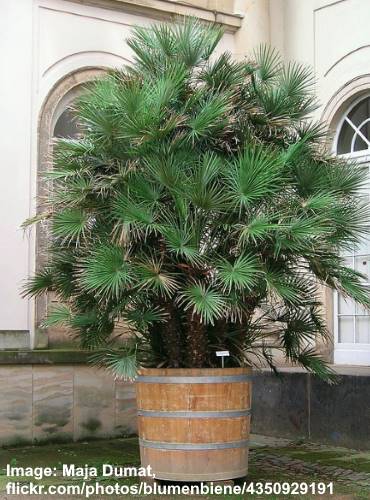
The dwarf European fan palm has few trunks and is small enough to suit many gardens
The European fan palm is a dwarf, shrub-like palm tree. The heat-loving, sun-loving palm is identified by its multiple trunks with a shaggy appearance. It has fine-textured, silvery-green fan-shaped fronds growing up to 5 ft. (1.5 m). The slow-growing palm only grows a few inches per year.
A benefit of growing the European fan palm in a container outdoors is that it’s exceedingly cold-hardy palm. This makes the potted palm suitable for landscaping in temperate climates. Additionally, the palm has excellent heat, drought, and wind tolerance.
Suitable for USDA zones 8 to 11.
Lady Palm (Rhapis excelsa)

The lady palm is a multi stem tree that you can grow outdoors in a pot
Similar to the bamboo palm, the lady palm is characterized by glossy green, fan-shaped leaves growing on bamboo-like canes. The easy-to-grow container palm tree grows in clumps and can reach heights of up to 13 ft. (4 m). However, its slow growth means it takes years for the palm to grow so tall.
Potted lady palm trees grow outdoors in USDA zones 9 through 11. The sturdy woody canes and large, leafy foliage add a tropical accent to garden landscapes. The lady palm grows well in north-facing gardens as it’s tolerant to part shade and full shade. Use the potted palm as an accent plant, foundation plant, or to add evergreen foliage to a patio.
Fishtail Palm (Caryota mitis)
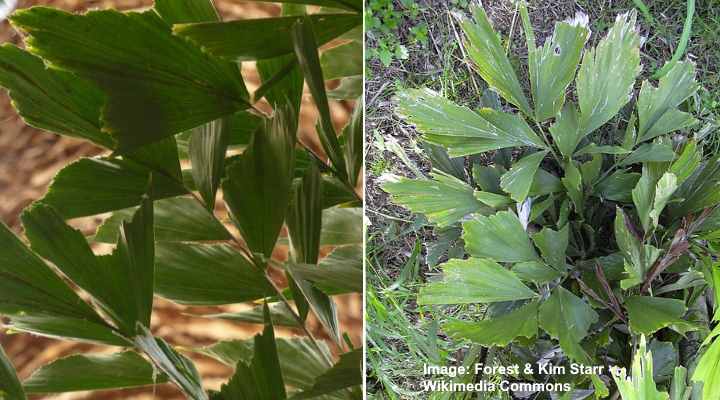
The interesting leaves of the fishtail palm add unique decorative element to any outdoor space
The fishtail palm is an ornamental tropical plant that grows in clumps of several slender stems with masses of attractive feathery fronds. The identifying feature of this palm plant is its unusual leaves in the shape of jagged fishtails. These huge yellowish-green leaves can grow up to 10 ft. (3 m) long.
Fishtail potted palm plants have several uses in subtropical landscapes. They can be placed as a privacy screen near a pool, backdrop for tropical plantings, or specimen plants. The tall leafy palm trees also make for excellent accents at the corner of a house.
Grow outdoors in USDA zones 9b through 11.
Kentia Palm (Howea forsteriana)

Kentia palm is a hardy and easy to care for palm plant
The kentia palm is an attractive potted palm due to its upright, elegant appearance. In addition, the single-stemmed palm is known for its dark green pinnate feathery leaves that grow up to 7 ft. (2.1 m) long. Although the decorative palm tree grows up to 40 ft. (12 m) in a garden, it will be significantly smaller in a container.
You can place a potted kentia palm on a patio or deck in a shaded location. The dark green elegant crown adds a tropical accent to any landscape. Additionally, being cold-hardy, the kentia palm tree can grow well in containers outdoors in zones 9b – 11 and survive short freezing temperature spells.
Sentry Palm (Howea belmoreana)

Keep sentry palm plant in a smaller pot to restrict its growth
The sentry palm tree is an ornamental plant with a slender ringed stem, enormous arching fronds, and a rounded crown. Compared to the related kentia palm, the sentry palm growth is more upright than drooping.
The sentry palm grows up to 33 ft. (10 m) in the ground, but a potted palm will grow slower and not as tall.
Grow outdoors in USDA zones 9b through 11.
Pygmy Date Palm (Phoenix roebelenii)
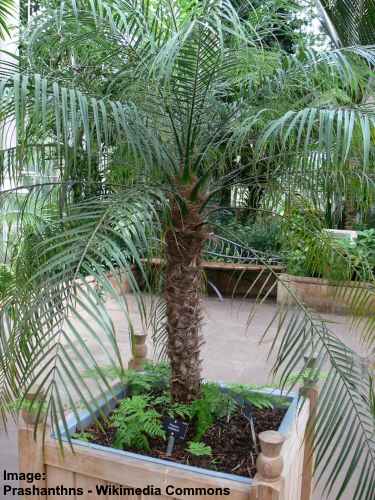
A potted pygmy date palm doesn’t take a lot of space outdoors
The pygmy date palm is a small palm tree when grown outdoors in containers. This popular ornamental palm tree has a slender habit and features feathery fronds growing 3 to 4 ft. (1 – 1.2 m) long. The drooping, arching stems create an attractive crown of spiky green foliage.
As a potted palm plant, the fruit-bearing palm grows around 6.5 ft. (2 m). Suitable landscape uses for the pygmy date palm include a specimen container plant, shade palm, or to accent an entranceway.
The small, graceful potted pygmy palm plant thrives in USDA zones 10 and 11 and is best planted in partial sun with some shade at midday.
Lipstick Palm (Cyrtostachys renda)
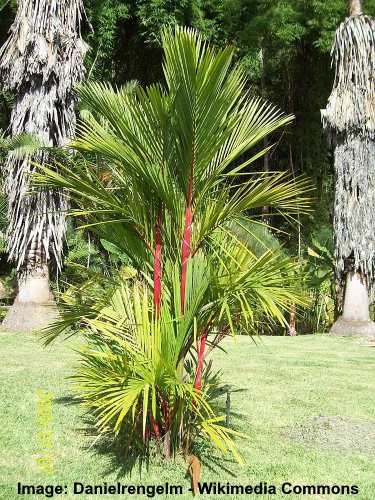
The lipstick palm is a small tree with distinctive red stems that can be grown in containers
The lipstick palm is a striking palm tree that features eye-catching red stems and crown shafts. The slender green and red trunks produce upward arching green fronds of pinnate leaves and pale green flowers, followed by small black palm fruits. In cultivation, the small to medium-sized palm grows 13 to 26 ft. (4 – 8 m) tall.
Lipstick palms get their name from their brightly-colored shafts and stems. Other names for this exotic palm tree include red sealing wax palm, Rajah wax palm, and red candle wax plant.
Although this is a sought-after potted palm for landscaping, the lipstick palm is tricky to grow in gardens. The tropical palm isn’t tolerant of heat, drought, salt, or high winds. Also, it’s cold-sensitive and will die in temperatures below 50°F (10°C).
The beautiful palm is suitable for growing in USDA zones 10 and 11.
Bismarck Palm (Bismarckia nobilis)

In the picture: a young Bismarck tree. Bismarck palm tree has beautiful silvery gray foliage and is cold sensitive
The Bismarck palm is a striking landscaping palm tree due to its attractive thick trunk and steely-blue fan-shaped fronds that are almost round. The silver Bismarck fronds grow up to 4 ft. (1.2 m) wide and create a dramatic statement in a landscape.
The slow-growing silvery palm will eventually grow around 40 ft. (12 m) tall and 10 ft. (3 m) wide. The heat-loving palm is suitable for USDA growing zones 10 and 11.
As a potted palm tree, the Bismarck palm will grow for several years in a container. The best—and probably only—landscape use is as a spectacular specimen container plant. However, the vast girth of the palm tree means it will eventually grow too large to continue growing in a container.
How to Care for Potted Palm Tree
To successfully grow a potted palm in a garden landscape, choose a location with the correct sun exposure. The palm tree should grow in a loamy, well-draining potting mix that is consistently moist with regular watering. Keep the palm healthy by applying a slow-release fertilizer for palms in springtime.
How Often Should You Water Potted Palm Tree
Water a potted palm tree outdoors whenever the top 1” (2.5 cm) of soil is dry. Typically, it would be best to water the palm tree every two or three days during hot weather and less in winter. Ideally, the potting palm soil mix should be constantly moist without becoming too soggy.
To know when to water the potted palm tree, poke your finger an inch (2.5 cm) into the soil. If the soil feels slightly damp, wait a day or two before testing it again. Alternatively, you can use a soil moisture monitoring tool to know how often to water a potted palm tree.
When should you water a palm tree growing in a pot? The ideal time to water a container palm tree is morning or evening. This is when the sun isn’t too intense or hot, and there is less risk of leaf burn.
Generally, potted palm trees require more frequent watering than palm trees growing in the ground.
The Best Potting Soil for Outdoor Palm Trees Growing in Containers
The ideal potting mix for growing a small palm in a container should be light, loamy, and well-drained. To make a simple potting soil mix for palms, use half peat moss and half coarse sand or perlite. Alternatively, you can buy a commercial potting mix suitable for succulents and cacti.
Related articles:
- Types of Palm Trees – Identification
- Small or Dwarf Palm Trees
- How to Grow Indoor Palm Trees as Houseplants
